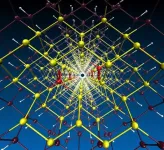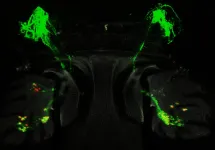(Press-News.org) The electron is one of the fundamental particles in nature we read about in school. Its behavior holds clues to new ways to store digital data.
In a study published in Nano Letters, physicists from Michigan Technological University explore alternative materials to improve capacity and shrink the size of digital data storage technologies. Ranjit Pati, professor of physics at Michigan Tech, led the study and explains the physics behind his team's new nanowire design.
"Thanks to a property called spin, electrons behave like tiny magnets," Pati said. "Similar to how a bar magnet's magnetization is dipolar, pointing from south to north, the electrons in a material have magnetic dipole moment vectors that describe the material's magnetization."
When these vectors are in random orientation, the material is nonmagnetic. When they are parallel to each other, it's called ferromagnetism and antiparallel alignments are antiferromagnetism. Current data storage technology is based on ferromagnetic materials, where the data are stored in small ferromagnetic domains. This is why a strong enough magnet can mess up a mobile phone or other electronic storage.
Depending on the direction of magnetization (whether pointing up or down), data are recorded as bits (either a 1 or 0) in ferromagnetic domains. However, there are two bottlenecks, and both hinge on proximity. First, bring an external magnet too close, and its magnetic field could alter the direction of magnetic moments in the domain and damage the storage device. And, second, the domains each have a magnetic field of their own, so they can't be too close to each other either. The challenge with smaller, more flexible, more versatile electronics is that they demand devices that make it harder to keep ferromagnetic domains safely apart.
"Ultrahigh-density data packing would be a daunting task with ferromagnetic memory domains," Pati said. "Antiferromagnetic materials, on the other hand, are free from these issues."
On their own antiferromagnetic materials aren't great for electronic devices, but they're not influenced by outside magnetic fields. This ability to resist magnetic manipulation started getting more attention from the research community and Pati's team used a predictive quantum many-body theory that considers electron-electron interactions. The team found that chromium-doped nanowires with a germanium core and silicon shell can be an antiferromagnetic semiconductor.
Several research groups have recently demonstrated manipulation of individual magnetic states in antiferromagnetic materials using electrical current and lasers. They observed spin dynamics in the terahertz frequency -- much faster than the frequency used in our current data storage devices. This observation has opened up a plethora of research interests in antiferromagnetism and could lead to faster, higher-capacity data storage.
"In our recent work, we have successfully harnessed the intriguing features of an antiferromagnet into a low-dimensional, complementary metal-oxide compatible semiconductor (CMOS) nanowire without destroying the semiconducting property of the nanowire," Pati said. "This opens up possibilities for smaller and smarter electronics with higher capacity data storage and manipulation."
Pati adds that the most exciting part of the research for his team was uncovering the mechanism that dictates antiferromagnetism. The mechanism is called superexchange and it controls the spin of electrons and the antiparallel alignment that makes them antiferromagnetic. In the team's nanowire, germanium electrons act as a go-between, an exchanger, between unconnected chromium atoms.
"The interaction between the magnetic states of the chromium atoms is mediated by the intermediate atoms they are bonded to. It is a cooperative magnetic phenomenon," Pati said. "In a simple way, let us say there are two people A and B: They are far apart and cannot communicate directly. But A has a friend C and B has a friend D. C and D are close friends. So, A and B can interact indirectly through C and D."
Better understanding how electrons communicate between atomic friends enables more experiments to test the potential of materials like chromium-doped nanowires. Better understanding the germanium-silicon nanowire material's antiferromagnetic nature is what boosts potential for smaller, smarter, higher capacity electronics.
INFORMATION:
The Volcano Alert Level (VAL) system, standardized by the United States Geological Survey (USGS) in 2006, is meant to save lives and keep citizens living in the shadow of an active volcano informed of their current level of risk.
A new study published in Risk Analysis suggests that, when an alert remains elevated at any level above "normal" due to a period of volcanic unrest, it can cause a decline in the region's housing prices and other economic indicators. Because of this, the authors argue that federal policymakers may need to account for the effects of prolonged volcanic unrest -- not just destructive eruptions -- in the provision of disaster relief funding.
A team of geoscientists and statistical experts examined the historical relationship ...
As researchers push the boundaries of battery design, seeking to pack ever greater amounts of power and energy into a given amount of space or weight, one of the more promising technologies being studied is lithium-ion batteries that use a solid electrolyte material between the two electrodes, rather than the typical liquid.
But such batteries have been plagued by a tendency for branch-like projections of metal called dendrites to form on one of the electrodes, eventually bridging the electrolyte and shorting out the battery cell. Now, researchers at MIT and elsewhere have found ...
Even though a fruit fly doesn't have ears, it can hear with its antennae. In a END ...
The first known study to explore optimal outpatient exam scheduling given the flexibility of inpatient exams has resulted in shorter wait times for magnetic resonance imaging (MRI) patients at END ...
FINDINGS
A new UCLA study shows that while men and women who have high muscle mass are less likely to die from heart disease, it also appears that women who have higher levels of body fat -- regardless of their muscle mass -- have a greater degree of protection than women with less fat.
The researchers analyzed national health survey data collected over a 15-year period and found that heart disease-related death in women with high muscle mass and high body fat was 42% lower than in a comparison group of women with low muscle mass and low body fat. However, women who had high muscle mass and low ...
A global review of coastal drowning science has found there is only one study worldwide that has evaluated beach safety education programs in schools.
Researchers from UNSW's Beach Safety Research Group have conducted the first in-depth review specific to coastal drowning.
The study, published in PLOS ONE, reviewed 146 coastal drowning studies from around the world.
"We found that evaluation of coastal drowning prevention strategies is rare," said William Koon, the lead author of the study and a PhD candidate in the School of Biological, Earth ...
The National Science Foundation (NSF) selected an NYU Tandon School of Engineering professor who is developing new approaches to training deep learning (DL) artificial intelligence frameworks, to receive its most prestigious award for promising young academics.
Anna Choromanska, an assistant professor in the Department of Electrical and Computer Engineering (ECE), received a 2021 NSF Faculty Early Career Development Award, more widely known as a CAREER Award, which supports early-career faculty who have the potential to serve as academic role models in research and education.
A five-year, $532,892 grant will support a project that focuses on new, more efficient ways of training ...
The continuous improvement of imaging technology holds great promise in areas where visual detection is necessary, such as with cancer screening. Three-dimensional imaging in particular has become popular because it provides a more complete picture of the target object and its context.
"More doctors and radiologists are looking at these 3D volumes, which are new technologies that allow you to look not just at one image, but a set of images," said UC Santa Barbara psychology professor Miguel Eckstein(link is external), whose expertise lies in the field of visual search. "In some imaging modalities this gives doctors information about volume and it allows them to segment what they're interested in."
Common wisdom is that with all ...
Bring on Twilight. Lee Child's Jack Reacher? Yes, please. More of James Patterson's Alex Cross while we're at it. And let's finish off with revisiting the million-plus words of the Harry Potter saga.
No one will confuse the above book series with high literature. But a new study published in the journal Reading and Writing shows that the more people read any kind of fiction -- even mass market stuff sniffily derided as pulp -- the better their language skills are likely to be.
The piece was written by Sandra Martin-Chang, professor of education in the Faculty of Arts and Science, and PhD student Stephanie Kozak. They found that people who enjoyed reading fiction for leisure and who identified as a reader scored higher on language tests, whereas ...
It's not uncommon for crescent-shaped swaths of sand to dot the shorelines of meandering rivers. These swaths usually appear along the inner side of a river bend, where the bank wraps around the sandy patch, forming deposits known as a "point bars."
When they appear along an outer bank, which curves the opposite way, they form "counter-point" bars, which are usually interpreted by geoscientists as an anomaly: a sign that something - such as a patch of erosion-resistant rocks - is interfering with the river's usual manner of sediment deposition.
But according to research led by The University of Texas at Austin, counter-point bars are not the oddities they're often ...


